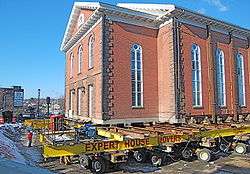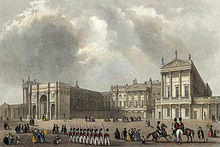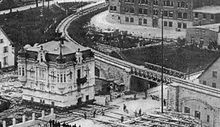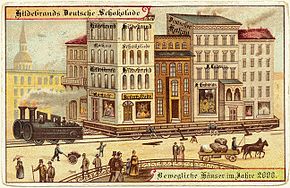- Structure relocation
-
Hydraulically powered dollies move an historic 19th century church in Salem, Massachusetts.

A structure relocation is the process of moving a structure from one location to another. There are two main ways for a structure to be moved: disassembling and then reassembling it at the required destination, or transporting it whole. For the latter, the building may be pushed on temporary rails or dollies if the distance is short. Otherwise, wheels, such as flatbed trucks, are used. These moves can be complicated and require the removal of protruding parts of the building, such as the chimney, as well as obstacles along the journey, such as overhead cables and trees.
Reasons for moving a building range from commercial reasons such as scenery, to preserving an important or historic building. Moves may also be made simply at the whim of the owner, or to separate a building from the plot of land that it stands on.
Contents
Equipment
Elevating a whole structure is typically done by attaching a temporary steel framework under the structure to replace and improve upon the structure's foundation. A network of hydraulic jacks placed under the framework, controlled by a unified jacking system, elevates the structure off the foundation. Large wood beams called cribs, stacked into piles, are used to inexpensively support the structure as the hydraulic jacks are repositioned higher on the crib piles to elevate the structure the next increment. Once the structure is at a sufficient height, a flat bed truck or hydraulic dollies are placed under the steel framework to support moves to the final destination. After the move across geography, to a newly prepared foundation, the structure is lowered reversing the steps just applied.
Notable moves
Whole moves
In order to save a single tree, Mustafa Kemal Atatürk moved the Yalova Köşk 4 meters to the east in the summer of 1936. [2] The Gem Theatre and Century Theatre, both housed within the same building in Detroit, were moved five-blocks on wheels to its new location at 333 Madison Avenue on 16 October 1997, because of the development of the Comerica Park area when it became home of the Detroit Tigers. At a distance of 563 meters (1,850 ft) it is the furthest known relocation of a sizable building.[1] As part of the Minnesota Shubert Performing Arts and Education Center development the Shubert Theatre was moved between 9 February 1999 and 21 February 1999. The 2,638 tonne (2,596 short ton) building was moved three city blocks and is the heaviest recorded building move done on wheels.[2]
London's famous monument Marble Arch was originally the entrance to the newly rebuilt Buckingham Palace but it was found to be too narrow for the state coach. It was moved to its present location of Hyde Park in 1851.[3]
The 850 tonne Belle Tout lighthouse was built in 1831 and located near the edge of the cliff on the next headland west from Beachy Head, East Sussex, England. It was moved more than 17 metres (50 ft) further inland in 1999 due to cliff erosion. It was pushed by four hydraulic jacks along four steel and concrete beams to a new site that was designed specifically to allow for possible future relocations.[4]
In 1999, the 208-foot (63 m) tall, 2540-tonne Cape Hatteras Lighthouse was moved 2900 feet (883 m) to protect it from being undermined by beach erosion. When it was built in 1870, the lighthouse was over 1,500 feet (460 m) from the sea, but by 1935 the beach had eroded and the waves were only 100 feet (30 m) away. Starting in 1930 many efforts to halt the erosion were attempted, including adding over a million cubic yards of loose sand, massive sandbags, and steel and concrete walls. After nearly 70 years it became apparent that fighting the erosion was a never-ending battle, and the decision was made to move the lighthouse away from the sea.
The 3,200-year-old Statue of Ramesses II in Cairo was moved on 25 August 2006 from Ramses Square to a new museum site. The statue was slowly being damaged by pollution and was in an area where it was difficult for people to visit. The move of the statue, which measures 11 metres (36 ft) high and weighs around 83 tonnes (91 short tons) was broadcast live on Egyptian television. Transported whole on the back of two trucks, the statue had previously been cut into eight pieces when it was moved from its excavation site in the mid 1950s.[5]
In June 2008, Hamilton Grange National Memorial, the 1802 home of Alexander Hamilton in New York City, was relocated from a cramped lot on Convent Avenue to a more spacious setting facing West 141st Street in nearby St. Nicholas Park, where it is currently undergoing a complete restortaion by John G. Waite Associates, Architects, PLLC (www.jgwaarchitects.com) restored. It is actually the second time the 298-ton mansion has been moved. In 1889, it was relocated from its original site on West 143rd Street.
Reassembly moves
Newspaper magnate William Randolph Hearst purchased and attempted to relocate two Cistercian monasteries during his travels in Spain, but neither was completed during his lifetime. The first was built about 1141, and found abandoned by Hearst in 1925. He purchased the ruin and attempted to ship it to his home in California, San Simeon. The crates, however, were detained by customs officials in New York City, and due to his deteriorating finances during the Great Depression, Hearst was unable to complete the shipment. The stones were purchased in 1951 and reassembled in Florida as a tourist attraction. In 1964, the building was purchased by a local Episcopal diocese and restored to its original purpose as the Church of St. Bernard de Clairvaux.[6]
Hearst's second attempt at relocating a monastery was in 1931, when he found the closed Santa Maria de Ovila Monastery, built around 1200. He purchased the structure, disassembled it and successfully shipped it to San Francisco, but was unable to rebuild the monastery. Hearst eventually gave the stones to the city of San Francisco, where they sat for decades in Golden Gate Park. Eventually some of the stones were acquired by the Abbey of New Clairvaux in Vina, California, where they are currently being reconstructed[7]; others are now being used as decorative accents in the San Francisco Botanical Garden.
In 1925, Thomas C. Williams Jr. bought a Tudor Revival manor house, Agecroft Hall which stood by the River Irwell in Pendlebury, England. The hall was dismantled, crated and transported to Richmond, Virginia where it was rebuilt as the centrepiece of a Tudor estate on the banks of the James River.[8]
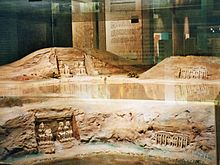 Model showing relative positions of the Abu Simbel temples before and after their 1960s relocation
Model showing relative positions of the Abu Simbel temples before and after their 1960s relocation
Abu Simbel is an archaeological site comprising two massive rock temples in southern Egypt on the western bank of Lake Nasser. In 1959, an international donation campaign began to save the monuments of Nubia: the southernmost relics of this ancient human civilisation were under threat from the rising waters of the Nile resulting from construction of the Aswan High Dam. The salvage of the Abu Simbel temples began in 1964, and cost US $80 million. Between 1964 and 1968, the entire site was cut into large blocks, dismantled and reassembled in a new location – 65 m higher and 200 m back from the river, in what many consider one of the greatest feats of archaeological engineering. Today, thousands of tourists visit the temples daily. Guarded convoys of buses and cars depart twice a day from Aswan, the nearest city. Many visitors also arrive by plane, at an airfield that was specially constructed for the temple complex.
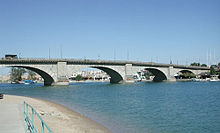 Rebuilt London Bridge in Lake Havasu City, Arizona
Rebuilt London Bridge in Lake Havasu City, Arizona
On 18 April 1968, John Rennie's London Bridge (which had replaced the original bridge in 1831) was sold to the American entrepreneur Robert P. McCulloch of McCulloch Oil for the sum of $2,460,000. The bridge was reconstructed at Lake Havasu City, Arizona, and opened on 10 October 1971. Not all of the bridge was transported to America, as some was kept behind in lieu of tax duties. The version of London Bridge that was rebuilt at Lake Havasu consists of a concrete frame with stones from the old (but not the original) London Bridge used as cladding. It spans a canal that leads from Lake Havasu to Thomson Bay, and forms the centrepiece of a theme park in English style, complete with mock-Tudor shopping mall. The bridge has become one of Arizona's biggest tourist attractions.[9]
The Old Wellington Inn and Sinclair's Oyster Bar in Shambles Square, Manchester, England, two of Manchester's oldest buildings dating from the 16th century and 17th century respectively, have been moved twice. Originally sited on Manchester's marketplace, they were raised 4 feet 9 inches (1.45 m) when the area was refurbished as Shambles Square in the 1960s.[10] They were in close proximity to the 1996 Manchester bombing and as part of the rebuilding of the area, they were taken apart and moved 100 m North to a position next to Manchester Cathedral in the new Shambles Square.[11]
Museum collections
Several museums incorporate historic buildings into their surroundings, with some dedicated to showing what life was like in previous centuries.
Museums that have transported and reconstructed old buildings and structures include:
- Avoncroft Museum of Historic Buildings, Bromsgrove, Worcestershire, England; centered on a collection of buildings which had to be relocated from their original sites and restored, along with a fully functioning windmill, a 1940s prefab, and the UK national collection of telephone kiosks.
- Beamish Museum, Stanley, County Durham, England; shows what life was like in a typical northern town in the early 20th century.
- Black Country Living Museum, Dudley, West Midlands, England; forty-two separate displays, including houses, shops and public buildings rebuilt to create a single early 20th century street.
- The Cloisters, New York City, a branch of the Metropolitan Museum of Art dedicated to the art and architecture of the European Middle Ages.
- Greenfield Village (The Henry Ford Museum), Dearborn, Michigan, which contains many historically significant buildings from around the United States, as well as a 17th century farm from Cotswold, England.
- History Park at Kelley Park, San Jose, California, features historic city buildings which have been moved from their original locations. The History Park is an indoor/outdoor museum, arranged to replicate a small United States town from the 19th century with both original and historically accurate recreations of architecturally significant buildings.
- Old Sturbridge Village, Sturbridge, Massachusetts, a recreated New England village with 40 structures.
- Peabody Essex Museum, Salem, Massachusetts, a museum which features some relocated historic buildings, including Yin Yu Tang, a late Qing dynasty merchant's house from southwestern China.
- The St Fagans National History Museum near Cardiff, Wales consists almost entirely of relocated buildings from across Wales, aiming to chronicle the lifestyle, culture and architecture of the Welsh people.
- Strawbery Banke, Portsmouth, New Hampshire, a historic seaport neighborhood museum. Although most of the Colonial and Federal style buildings are in situ, some were moved for preservation.
- Woodman Institute, Dover, New Hampshire, features the 1675 William Damm Garrison House, New Hampshire's oldest intact garrison house, relocated to the museum's grounds in 1915 from elsewhere in the city.
- Weald and Downland Open Air Museum, Singleton, Sussex, England, has almost 50 relocated historic buildings from the South East dating from between the 12th century to 19th century.
Reasons for moving a structure
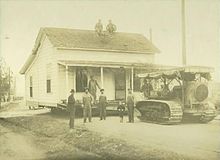 Bulldozer relocating a house in c. 1920
Bulldozer relocating a house in c. 1920
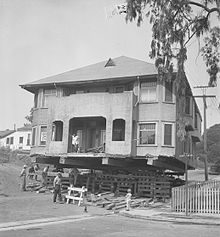 House being moved to make way for construction of Hollywood Freeway, California, 1948
House being moved to make way for construction of Hollywood Freeway, California, 1948
There are several reasons why a structure may be moved. For example, a redevelopment, such as urban regeneration, could cause a relocation. Additionally, it has been purchased and the buyer wishes to move it, for reasons such as the scenery from the building. The owner might also sell the land that the building is on, but keep the building.[12]
Another reason for the relocation of a building is to preserve it for historic interest. An example of such preservation is the Lin-An Tai building in Taiwan. Such a move could be made because a building is in danger at its present location.[13]
Relocation of towers
In the past, it was not uncommon that as well free-standing as guyed radio towers were dismantled and rebuilt at another site. In some cases they were rebuilt just a few metres away from their original site, but in others far away from their original site. In first case these towers were nearly all part of a directional antenna system for long- and medium-wave for which the regulations of directional patterns were changed and the best way to fulfill it, was to build either a new tower or to dismantle one tower and to rebuild it on the new site. It was also done that a tower was dismantled and then used for the upper parts of a new radio tower. This was done for example with the masts at Sender Donebach in 1982 and with the wooden tower of Transmitter Ismaning in 1934. After World War II some radio towers in former East Germany were dismantled by Soviet occupants and rebuilt in former Soviet Union, the most famous example herefore is Goliath transmitter. It is also common that electricity pylons are dismantled and rebuilt at a new site. Also small observation towers built of steel were sometimes dismantled for renovation and afterwards rebuilt.
Financing building relocation
Although larger projects are usually paid for in cash, smaller projects such as the relocation of a house to a new site are typically financed by banks. Finance is often a major problem faced by project managers as the house needs to be paid for prior to leaving its current site, but the lender for the project cannot take security over the house until it is complete and on the new site. This creates a short-term cashflow problem that unhinges many projects.
Records
The tallest structure ever relocated is BREN Tower. In 1959 a 280-metre-tall radio mast was relocated at Felsberg-Berus without dismantling [3]
See also
- Lloyd's building
- Parachute Jump, Coney Island, Brooklyn, New York
- Hunting Island Light
- Cape Canaveral Light
- Baltic Exchange
- Cooks' Cottage
- BREN Tower
- Goliath transmitter
- Longwave transmitter Europe 1
- Bodenseesender
- Category:Relocated buildings and structures
References
- ^ Guinness World Records. "Farthest Building Relocation". Accessed 27 August 2006.
- ^ Guinness World Records. "Heaviest Building Moved On Wheels". Accessed 27 August 2006.
- ^ BBC News. 28 February 2005. "Marooned Marble Arch may be moved". Accessed 27 August 2006.
- ^ BBC News. 19 March 1999. "Lighthouse megamove complete". Accessed 27 August 2006.
- ^ BBC News. 25 August 2006. "Giant Ramses statue gets new home". Accessed 27 August 2006.
- ^ South Florida Sun-Sentinel. "Ancient Spanish Monastery". Accessed 29 August 2006.
- ^ National Trust for Historic Preservation. "Stone By Stone". Accessed 29 August 2006.
- ^ Agecroft Hall: A Tudor estate originally built in 15th-century England, now a Richmond Virginia museum
- ^ http://www.outwestnewspaper.com/london.html Retrieved on 2008-03-11
- ^ http://www.gmcro.co.uk/Photography/locations/Wellington.htm Retrieved on 2008-03-11
- ^ Manchester Civic Society. 1996. "[1]PDF (388 KiB)". Accessed 18 September 2006.
- ^ "Why Relocate?". Mammoth Movers. http://www.mammothmovers.com/why_relocate. Retrieved 2008-03-24.
- ^ "ETD Database". Digital Library and Archives. 2003-10-21. Archived from the original on 2008-04-16. http://web.archive.org/web/20080416154940/http://thesis.lib.cycu.edu.tw/ETD-db/ETD-search/view_etd?URN=etd-0919106-184612. Retrieved 2008-03-24.
External links
- International Association of Structural Movers
- 'Monster Moves' Television Series made by Windfall Films Follows Buildings On The Move
- "Moved Buildings for Museums: not an easy solution"
- "Moving the Cape Hatteras Lighthouse"
- Cape Hatteras Lighthouse Relocation Articles and Images - U.S. Department of the Interior, National Park Service - information on the 880 meter move of Cape Hatteras lighthouse in the Outer Banks of North Carolina
- "German church rolled to new home" at BBC News, 23 October 2007
- Smith, James Walter (June 1897). "How buildings are moved". Strand Magazine (London: Newnes) 13 (78): 681–689. http://books.google.com/books?id=COkvAAAAMAAJ&pg=PA681. Retrieved December 6, 2010.
- "House moving in Chicago". Journal of the Society of Estate Clerks of Works (Winchester) 3 (20): 40. February 1, 1890. http://books.google.com/books?id=gr_HAAAAIAAJ&pg=RA2-PA40. Retrieved December 6, 2010. Includes statistics such as about 100 firms in Chicago. Costs: Small frame house $200/mile; Brick house $1/foot.
- "[La Plant-Choate house-moving trucks Ad"]. Building Age and The Builders' Journal (New York: Building Age) 44 (12): 82. December 1922. http://books.google.com/books?id=eF3lAAAAMAAJ&pg=RA1-PA82. Retrieved December 6, 2010. Ad showing trucks on bottom-right of page.
Categories:- Civil engineering
- Moving and relocation
Wikimedia Foundation. 2010.

